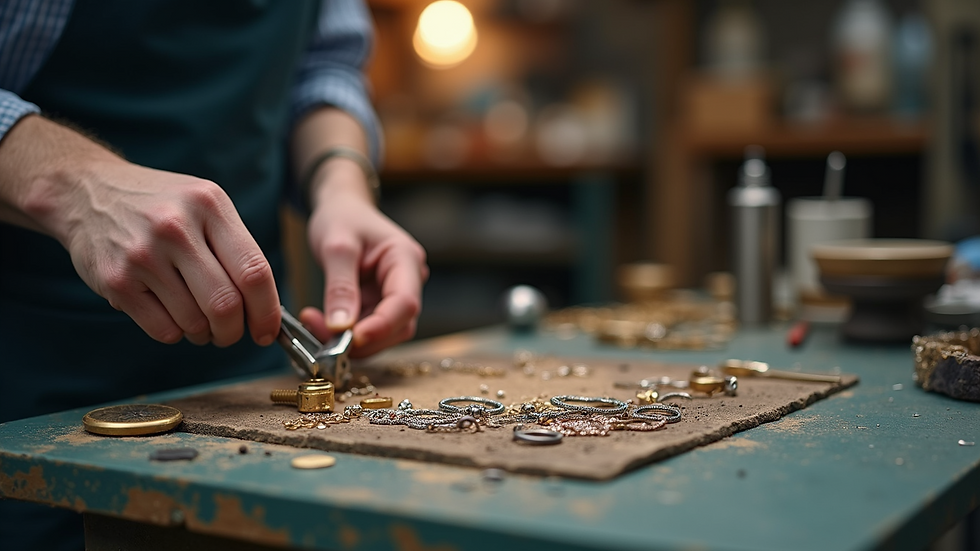Exploring the Timeless Craftsmanship of Fine Jewelry
- LoveMaille
- Jun 24
- 4 min read
Fine jewelry has captivated hearts and minds for centuries. It represents status, sentiment, and, most importantly, craftsmanship. From intricate designs to the careful selection of stones, creating fine jewelry is both an art and a science. This post will delve into the aspects of fine jewelry that showcase its timeless craftsmanship.
The Definition of Fine Jewelry
Fine jewelry is defined by its use of high-quality materials, such as gold, platinum, diamonds, and gemstones. It transcends simple adornment and reflects the skill of talented artisans. The craftsmanship involved in fine jewelry is what sets it apart from costume jewelry.
Jewelry lovers treasure fine pieces not only for their beauty but also for their value. According to a report by the Jewelers of America, the fine jewelry market size was valued at over $300 billion in 2022 and is expected to see significant growth in the coming years. This highlights the enduring appeal and investment potential of fine jewelry.

The Art of Jewelry Making
Creating fine jewelry begins with a concept or inspiration. Designers often draw from nature, culture, and personal experiences. The first step is sketching out designs, which will then be transformed into physical pieces by skilled artisans.
Once the design is finalized, selecting the right materials is crucial. High-quality metals must be chosen to ensure longevity and appearance. For example, 18k gold is a popular choice due to its balance of durability and luster.
Emerging technologies, such as CAD (Computer-Aided Design), have also revolutionized how jewelry is designed. Artisans can create detailed digital models, allowing for precise measurements and alterations before the actual crafting begins.

Techniques and Styles of Fine Jewelry
Fine jewelry encompasses various techniques and styles that showcase a craftsman's expertise.
Handcrafted: This technique requires immense skill and patience. Artisans create each piece by hand, ensuring unique characteristics. The handcrafted approach speaks to the individuality of each item.
Stone Setting: Properly setting stones is crucial for enhancing the beauty and security of gemstones. Techniques like prong, bezel, or pavé settings can dramatically alter a piece's overall look.
Engraving: Adding intricate designs or personalized messages through engraving can make a piece truly one-of-a-kind. It's often used for wedding bands and special commemorative items.
Enamel Work: This traditional technique involves adding color and decoration through the application of enamel. The translucent quality of enamel adds depth and a unique finish to jewelry.
Chain Making: This is where techniques like maille come in, emphasizing the connection between links to create beautiful, fluid designs. If you want to explore a variety of materials and styles, check out love maille for unique chain designs.
Through these techniques, artisans can develop distinctive styles, from vintage and classic to modern and avant-garde.

The Role of Fine Jewelry in Culture
Throughout history, jewelry has played a significant cultural role. Different cultures have various meanings and uses for jewelry. For instance:
Wedding Rings: In many cultures, rings symbolize eternal love. The custom of exchanging rings dates back thousands of years.
Signet Rings: Historically used to seal documents, signet rings convey authority and family heritage.
Amulets: Some cultures introduce amulets as protective charms, believed to ward off evil spirits or bring good fortune.
Understanding the cultural background of certain pieces can enhance their value and significance. It is fascinating to observe how fine jewelry adapts across different societies while maintaining its core meaning.
Caring for Fine Jewelry
Owning fine jewelry is a privilege, yet it comes with responsibilities. Proper care can extend the life and maintain the beauty of these cherished items.
Regular Cleanings: Regular cleaning can prevent dirt buildup. Use a soft cloth to polish your pieces and, if necessary, a mild soap and water solution for deeper cleaning.
Proper Storage: Store jewelry separately to avoid scratching. Use soft pouches or a dedicated jewelry box with compartments.
Professional Inspections: Periodically take your jewelry to a professional for inspection. They can check for loose stones, wear, or any necessary repairs.
Avoid Exposure: Keep your jewelry away from harsh chemicals, chlorine, and other substances that could damage the finish or stones.
Taking these simple steps can help ensure your fine jewelry remains as dazzling as the day you acquired it.
The Future of Fine Jewelry
The fine jewelry industry is evolving, especially with increased consumer interest in sustainability. Many brands are prioritizing ethically sourced materials and eco-friendly manufacturing processes.
Moreover, digital technologies are reshaping how consumers interact with jewelry. Virtual try-on tools and 3D printing are just starting to gain traction, allowing for innovative designs and a more personalized shopping experience.
Additionally, the growth of online retail continues to change the landscape of jewelry purchasing. Consumers can access various brands and styles with just a click, making fine jewelry more accessible than ever.
As we move forward, the blend of technology, sustainability, and artistry will shape the future of fine jewelry, allowing it to retain its relevance and allure.
Timeless Legacy of Fine Jewelry
The beauty of fine jewelry is that it transcends time and trends. The craftsmanship behind each piece tells a story, reflecting the skill and passion of its creator. Whether passed down through generations or acquired for personal enjoyment, fine jewelry represents more than ornamentation.
It embodies memories, emotions, and connections—making it timeless in every sense of the word. As you explore the world of fine jewelry, may you find not just exquisite pieces, but also the rich histories and emotions that make them truly special.





Comments